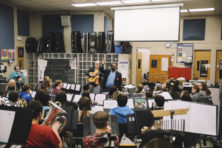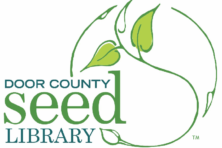Gardening in Schools
- Share
- Tweet
- Pin
- Share
Juniors at Sevastopol High School are getting a hands-on lesson in history – with seeds.
Tara LeClair, family and consumer-sciences teacher at Sevastopol, has a passion for home gardening and preserving. She was inspired by the Door County Seed Library’s Victory Gardens Initiative and wanted to take it into the classroom.
“We’re looking for ways to engage with our students in a very different way,” she said. “For me, [gardening is] a lot more than just growing food for my family. There’s a whole component of social-emotional wellness that’s attached to gardening – often called horticultural therapy. I thought this would be a really great thing to think about infusing into our curriculum.”
LeClair has partnered with the history and English teachers to create a multidisciplinary lesson that weaves gardening into their existing lessons. The junior class is now studying World War II in its American History class, learning about the battle on the homefront, including rationing and Victory Gardens. LeClair is quick to clarify that our food situation now with COVID-19 is not as dire as it was during WWII, but she still feels that gardening can provide an important lesson.
“There is an importance to teaching our younger generation about being self-sustainable and knowing where their food comes from and knowing how to grow their own food,” she said. “Between World War II and now, I think there are a couple of generations that have lost that, and I’m just hoping to reinvigorate that with some of our younger population.”
Each junior will receive seeds from the Door County Seed Library to grow at home. Seed packs will include 10 each of 10 assorted vegetables, herbs and flowers. LeClair plans to mail them to students in mid-May. Then students will write about their gardening experiences as part of their English-class assignments.
The Sturgeon Bay School District has been incorporating gardening into some classroom lessons – and lunches – for about a year and a half. The Waseda Farms Growing and Learning Lab is a greenhouse that teachers can use for lessons about growing. The school’s food-service department then buys the vegetables classes have grown and uses them in students’ lunches.
Jenny Spude, food services director, said that even though students are learning at home, those who have registered for the district’s meal program are still getting vegetables from the greenhouse in their lunches. Spude and her team are not only harvesting cucumbers and tomatoes that classes planted back in the fall, but they have also identified quick-growing crops such as spinach and kale that they could plant themselves to provide a fast, in-house source of produce for students’ meals.
“We’re able to use our greenhouse now in a way that we just hadn’t planned,” she said. “In this time of such uncertainty, we have a certain food system right now in the greenhouse.”
And Spude is taking it even one step further. She’s planning to give each student who currently receives meals through the district a spinach seedling from the greenhouse and a packet of spinach seeds from the Door County Seed Library so they can grow their own spinach at home. Although Spude said her primary goal is to give students another connection to school – in addition to the meals – that can give them some sense of normalcy during this time, the benefits can be even greater.
“We know that when kids get involved in growing their own food, they’re way more likely to taste it and eventually have it as something they eat on a regular basis.” Spude added, “It gives kids a sense of sustainability, knowing that they can be growing things on their own.”
In the midst of this pandemic, both Spude and LeClair are using seeds to help students grow.
“I hope that students walk out their back door and go in their garden and pick two handfuls of green beans and come back into their house and can prepare that for their families,” LeClair said. “To me, that’s a victory.”



